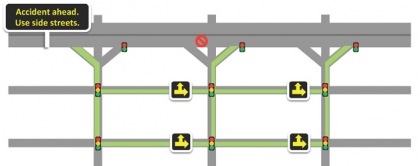Reducing Highway Congestion thru Software
Belta to Co-Lead $1 Million Study

Traffic congestion is a waste not only of time, but also of energy and money. In 2011, it caused Americans in metropolitan areas to spend 5.5 billion extra hours on the road and pump 2.9 billion extra gallons of fuel into their gas tanks, with associated costs reaching $121 billion—a nearly six-fold increase since 1982. Municipalities have attempted to mitigate traffic congestion through highway onramp metering and fees at peak travel times, but the problem continues to worsen.
Now a research team led by Associate Professor Calin Belta (ME, SE) and University of California, Berkeley Associate Professor Murat Arcak (EECS) is advancing a novel solution that could reduce congestion considerably. Supported by a three-year, $1 million grant from the National Science Foundation, the researchers plan to develop algorithms for a data-driven traffic management software system that optimizes the timing of traffic lights at both highway onramps and roadway intersections in real time.
The work represents a novel application of “formal methods,” a discipline within computer science focused on efficient techniques for proving the correct operation of systems ranging from computer programs to digital circuits, thus ensuring their reliability and robust performance.
“We want to develop a system in which we can guarantee specifications for traffic networks, just as we do for computer programs,” said Belta. “These specifications will include minimizing traffic jams and maximizing the flow of traffic, all while ensuring that pedestrians don’t have to wait a long time to cross the street.”
Whereas current traffic management systems can reduce traffic congestion within small networks of freeways and arterial roads, the formal methods approach promises to do so across much larger networks. In their algorithms, the researchers plan to partition a large road network into small sub-networks, and establish specifications so that enforcing desired traffic patterns in small sub-networks (and on roads linking one sub-network to another) guarantees desired traffic patterns in the original network.
The proposed techniques will be tested in current and upcoming traffic management projects in California sponsored by Caltrans, the state transportation agency. Applications include a prototype decision support system to be deployed along the Interstate 210 corridor north of Los Angeles, and coordinated ramp metering, arterial intersection and variable speed limit management on a freeway in Sacramento and a freeway-arterial interchange in San Jose.
Over the next three years, the team aims to accomplish three main tasks.
“We plan to develop the theory and algorithms to solve the problem, enable the system to accommodate extreme situations such as sporting events and accidents, and apply statistical methods to enhance its performance,” said Belta.